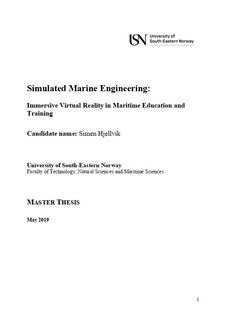| dc.description.abstract | For decades simulators have been embedded in the formal education in the field of
marine engineering, for training and assessment of competences and proficiencies. A new era
of simulator technology, by the use of head mounted display virtual reality, is emerging to the
field of maritime education and is currently unexplored in the context of marine engineer
training. This is an experimental study with the latest technological increment which was
conducted with a prototype immersive virtual reality simulator and a commercial 3D virtual
reality desktop simulator. By means of this novel head mounted display virtual reality and the
more familiar desktop option, the purpose of this study was to explore these technologies
through the potential end user.
A classic between-groups experimental design was developed with a simulation
exercise of starting a fuel oil separator for the treatment and tested with two marine
engineering student groups and one group of professional engineer officers. The recruited
sample frame was assigned either to the (i) 3D virtual reality desktop group (n=5), (ii)
immersive virtual reality novice group (n=6) or the (iii) immersive virtual reality expert group
(n=6). Instruments of declarative knowledge tests were constructed for measuring prior
knowledge prerequisite to the study, and for measuring accuracy and accessibility of retaining
knowledge acquired in the treatment. The results gained a significant difference in knowledge
acquisition between the two technologies (P=0.005) and between the group competence levels
(P=0.008). Instruments for measuring mental workload and the flow state were adopted from
the original frameworks to describe the experience. No technology discrimination could be
observed, though the group level experience measures indicated some difference and yielded
subservient effect sizes and significance. | nb_NO |
